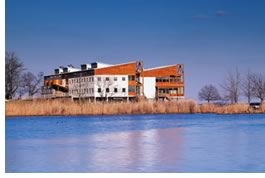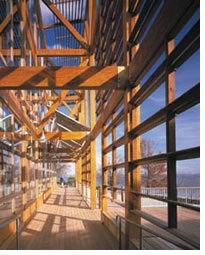
by Gregory Mella, AIA
 The
Chesapeake Bay Foundation Headquarters in Annapolis, Md., has garnered
awards ranging from an Architectural Record/Business
Week Award for demonstrating that "good design is good business,"
to the first Platinum LEED (Leadership in Energy and Environmental Design)
rating from the U.S. Green Building Council. In this article, SmithGroup's
project architect for the building explains some of the negotiation that
went into gaining approval for an innovative water-conservation system.
The
Chesapeake Bay Foundation Headquarters in Annapolis, Md., has garnered
awards ranging from an Architectural Record/Business
Week Award for demonstrating that "good design is good business,"
to the first Platinum LEED (Leadership in Energy and Environmental Design)
rating from the U.S. Green Building Council. In this article, SmithGroup's
project architect for the building explains some of the negotiation that
went into gaining approval for an innovative water-conservation system.
The most important piece of advice I'd give anyone incorporating new concepts in building systems is to start early and get the code officials involved from Day One.
 A
case in point with the Chesapeake Bay Foundation Headquarters is the system
that collects rain as nonpotable water—for hand washing and the fire
suppression system. We knew from the onset of the project that this was
a strategy we wanted to use in the building, so we sat down with the Maryland
Department of Public Health and the various code officials to find out
what we would need to do to be able to include such a system.
A
case in point with the Chesapeake Bay Foundation Headquarters is the system
that collects rain as nonpotable water—for hand washing and the fire
suppression system. We knew from the onset of the project that this was
a strategy we wanted to use in the building, so we sat down with the Maryland
Department of Public Health and the various code officials to find out
what we would need to do to be able to include such a system.
The officials were very skeptical at first because of the concern over the viruses and bacteria one can find in untreated rainwater, which would be a problem if, for instance, someone has an open cut on the hand. So we worked with the health officials to determine the appropriate level of rainwater filtration. We ended up developing a system specifically for this facility that combined a particulate filter; chlorine filter; and, to remove the chlorine, a carbon filter.
 Still,
rainwater isn't for drinking, so we further worked with the officials
on how to get that point across to the building users. At one point, they
wanted us to add dye to all that water so people would know not to drink
it. That didn't fit well with our goal of environmental sensitivity, so
we suggested alternatives. And that's the way the iterations would go.
We expressed our goal, they expressed their concerns, and we worked out
a compromise. We ultimately used signage at each of the sinks saying "Rainwater,
do not drink."
Still,
rainwater isn't for drinking, so we further worked with the officials
on how to get that point across to the building users. At one point, they
wanted us to add dye to all that water so people would know not to drink
it. That didn't fit well with our goal of environmental sensitivity, so
we suggested alternatives. And that's the way the iterations would go.
We expressed our goal, they expressed their concerns, and we worked out
a compromise. We ultimately used signage at each of the sinks saying "Rainwater,
do not drink."
 The
other element requiring negotiation was using rainwater for fire suppression.
The fire marshal wanted to know how we could guarantee that water is always
going to be in those tanks when we need it in the event of a fire. That
one was tricky, but we worked it out.
The
other element requiring negotiation was using rainwater for fire suppression.
The fire marshal wanted to know how we could guarantee that water is always
going to be in those tanks when we need it in the event of a fire. That
one was tricky, but we worked it out.
 Much
of the work we put into developing this water system could be attributed
to its being the first time the code officials had encountered the concept
in the field. It is somewhat easier to get approval for an unconventional
system if you can specify it off-the-shelf, even if it's "state-of-the-shelf."
An example might be the composting toilets we also designed into this
facility. Fortunately, this was the second project in the county to use
composting toilets, so we benefited. Moreover, a product backed by a manufacturer
and their independent testing really helps alleviate a lot of the building
officials' concerns. But it still wasn't a piece of cake. Any new system
or system the officials are not used to dealing with is going to raise
concerns.
Much
of the work we put into developing this water system could be attributed
to its being the first time the code officials had encountered the concept
in the field. It is somewhat easier to get approval for an unconventional
system if you can specify it off-the-shelf, even if it's "state-of-the-shelf."
An example might be the composting toilets we also designed into this
facility. Fortunately, this was the second project in the county to use
composting toilets, so we benefited. Moreover, a product backed by a manufacturer
and their independent testing really helps alleviate a lot of the building
officials' concerns. But it still wasn't a piece of cake. Any new system
or system the officials are not used to dealing with is going to raise
concerns.
As I said at the outset, the trick in a nutshell is to make the real effort to understand what the concerns are. Like us, the building officials are entrusted with protecting public health. We found they were also receptive to our additional goal of protecting the health of the environment. The code officials became a part of our team—people to work with, not around. The building officials were strongly supportive of what we were trying to do. And, ultimately, they are proud of the building, just as we are.
Copyright 2002 The American Institute of Architects. All rights reserved.
![]()
|
To see the client's pride in their green facility, visit the Chesapeake Bay Foundation site. Got a BEST PRACTICES tip on any subject that you'd like to share with your peers via AIArchitect This Week? Send an email to Managing Editor Stephanie Stubbs and tell her what it's about. We'll get in touch—we'll even write it for you!
|
|
